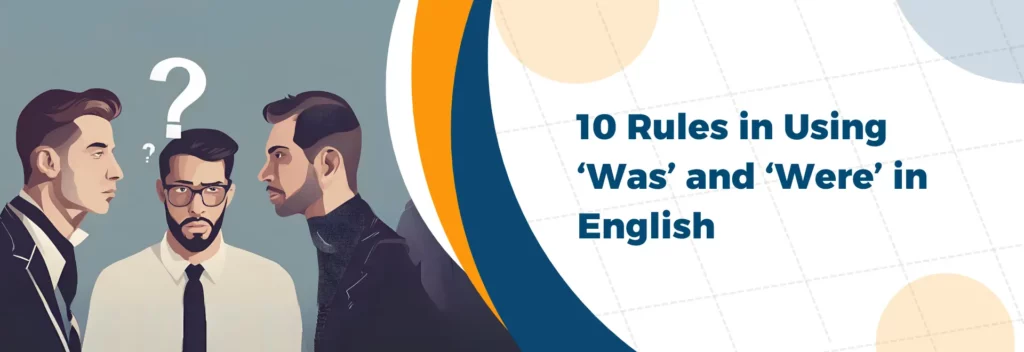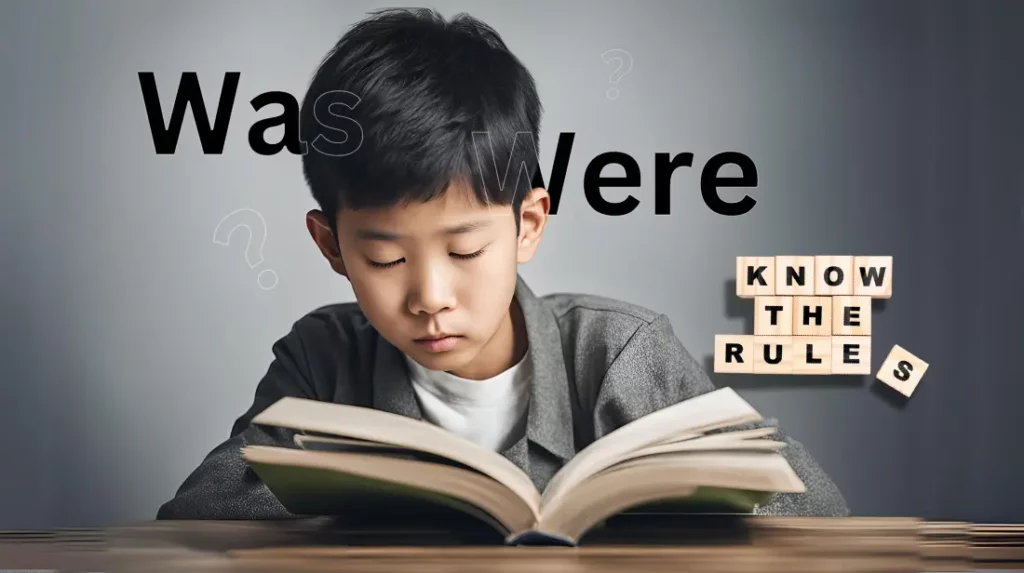
10 Reasons Why Using Was and Were in English is Not as Easy as You Think
Introduction
The English language grammar is quite complicated at first but it gets simple when you understand the rules. These two —was and were— are the most commonly used parts of speech in the English language. However, they have different functions, especially when trying to convey different meanings. For instance, “If I was you?” or “If I were you?” sentences, because these two are often mistakenly interchanged.
The was and were vary depending on the subject-verb agreement. Although it might not be obvious for English speakers, but for some grammar nazis, it could be frustrating for them. For this reason, it is important to always pay attention to the rules and conditions in the subject-verb agreement. Particularly, in using the was and were in the sentences.
What are WAS and WERE in English
These two are commonly used as the past tense of the to-be verbs: is, are, and am. Be-verbs help connect the subject and the verb or predicate to make a phrase or a sentence make sense. Moreover, they describe the quality or condition of something such as people, things, ideas, and places.
The different be-verb types are: am, is, are, was, were, been, and being. Specifically, “was” is the past tense of am and is, whereas, “were” is the past tense of are. They also vary in tenses such as simple, perfect, continuous, and present continuous sentence structures. Furthermore, as the subject changes, the ‘was’ and ‘were’ also change. Thus, you should be careful in using these, especially in complex sentences.
Moreover, they are also considered irregular verbs as they change in form when used in the past tense. Normally, past tenses of the verbs have -d, -ed, and -ied, attached to it. However, as for these two, they have another grammar rule.
The Difference between “Was” and “Were”
Was
- The word “was” is the past tense of the be-verb “am.”
- We used “was” for first-person singular and third-person singular.
- When stating facts or real historical events, use was.
- Use “was” when referring to a situation or action that really happened in the past.
- Use “There Was” when referring to a singular subject in the past.
Were
- The word “were” is the past tense of the be-verb “are.”
- We used “were” for the second-person singular and all plural forms of the nouns.
- When expressing imaginations or things that did not happen, use “were.”
- Use were when about scenarios that are not real or done hypothetically, or when making assumptions in the past.
- Use “There were” if there are plural subjects.

10 Rules When to Use Was and Were in English
There are different ways of using the words was and were in English, especially when it comes to compound and complex sentences. In this case, it can be possible to use them both in one sentence without destroying the main idea of the message. It all matters to the subject; thus, just keep reading the ten rules of using “was” and “were” in sentences thoroughly.
Rule 1. Was and Were: Singular and Plural Subjects
A singular subject is made of one noun like a person, an animal, an idea, or a thing. Thus, using ‘was” represents a subject in the past tense. On one hand, using “were” if the subjects are in plural forms. Below are examples of using was in past simple and past continuous tenses.
Examples:
Was
Past Simple:
- Sassa was hungry.
- Andre was in a hurry.
- The bird was small.
Past Continuous:
- Troy was eating a hamburger.
- The girl was waiting for the food.
- XYZ Town was experiencing a flash flood.
Were
Past Simple:
- Maloi and Peter were in the hospital.
- Two players were injured.
- The flowers were dry.
Past Continuous:
- The kids were playing basketball.
- The leaves were falling.
- Employees were complaining about the poor service.
Rule 2. Was and Were: First, Second, and Third-Person POV
Use “was” when the subject is in the first person point-of-view, which is the pronoun “I” in I am. Imply “was” if you want to use the third person point-of-view, “He, She, and It.” On the contrary use, “were” if the subject falls to the second person point-of-view, “You, We, and They.” The following are examples of this reason.
Examples:
Was
Past Simple:
- He was in the first place.
- She was the girl in the mirror.
- It was a small lovely bud.
Past Continuous:
- He was throwing pieces of trash everywhere.
- She was catching up on her lessons.
- It was falling from the sky.
Were
Past Simple:
- You were young then.
- We were so adorable in Elementary.
- They were the campus crushes in our school.
Past Continuous:
- You were reading a book.
- We were camping near the lake.
- They were gossiping about us.
Rule 3. Was and Were: Stating Facts and Wishes
Indicative sentences are when the events or scenarios truly happened in the past, use “was.” However, if the incident did not exist in the past or was done in hypothetical scenarios like wish, or imagination, then use “were.” Thus, the following are sets of examples regarding the matter.
Examples:
Was
Past Simple:
- Leonardo da Vinci was a famous painter.
- The COVID-19 was a global threat.
- Catriona Gray was the Miss Universe 2018.
Past Continuous:
- I was celebrating my birthday last week.
- Lea Salonga was playing the lead actress in Miss Saigon.
- Celine Dion was singing at the 2024 World Olympics Grand Opening.
Were
Past Simple:
- I wished I were braver.
- Althea wished she were his girlfriend.
- If John were handsome, he would get a girlfriend.
Past Continuous:
- Agatha wished she were walking the runway.
- Once I were to go flying, I would go to the moon.
- If only I were a superhero, I would save people.
Rule 4. Was and Were: If I was and If I were
A subjunctive mood conveys hypothetical messages, wishes, suggestions, and commands. This type of sentence consists of two verbs. The first verb is the indicative clauses, and the second represents the subjunctive mood —desires, commands, requests, impersonal expressions, doubts, and suggestions. Moreover, you use “If…was” if the action happened at some point in the past. Meanwhile, use “If…were” when you did not experience the action in the past.
Examples:
Was
Past Simple:
- If I was a good student, I could get a scholarship.
- My apologies, If I was angry lately, I was just hungry.
- If I was naughty, I could not get a new phone.
Past Continuous:
- Sorry If I was acting weird earlier, I had a personal problem.
- If I was doing something, just leave me alone.
- If she was crying out loud, just give her some food.
Were
Past Simple:
If I were you, I would take the flight to Spain.- If she were you, she would get a better life.
- If he were me, he could unlock his talents.
Past Continuous:
- If I were experiencing a great dilemma, I would run to you.
- If Allan were talking bad about me, I would slap him.
- If the cat were stealing my food, I might shove it away.
Rule 5. Was and Were: Collective Nouns
Collective nouns refer to a group of people, animals, or things treated as a whole. They are often used as singular groups unless there is a quantifier —a determiner or a pronoun that entails a specific quantity— on how many groups are mentioned. Below are examples of using was and were with collective nouns.
Examples:
Was
Past Simple:
- There was a cast of actors in the mall yesterday.
- An army of ants was eating a cake in the garden.
- There was a basket of fruits on the table.
Past Continuous:
- A cluster of spiders was crawling under the bed.
- There was a flock of birds flying in the sky.
- A range of mountains was dappling the village.
Were
Past Simple:
- There were three caravans of travelers in Okinawa.
- Two decks of cards were placed on the table.
- There were five herds of cows in the barn.
Past Continuous:
- Three cultures of bacteria were infecting the dog.
- There were five flocks of turkeys eating on a farm.
- The four faculty of teachers were having a meeting.
Rule 6. Was and Were: One of Something
This phrase is one of the most common mistakes in English grammar. When you use “one of the something,” you refer to only one person, thing, or idea of a whole group. Just because the noun is plural does not mean the verb should also be plural. It all matters to the quantifiers specified before the noun. The following are instances of how to use it accurately.
Examples:
Was
Past Simple:
- One of the flowers was gone.
- One of the puppies was black.
- One of the kids was sick.
Past Continuous:
- One of the birds was flying in the sea.
- One of the bees was looking for flowers.
- One of the children was throwing tantrums.
Were
Past Simple:
- 20% of the flowers were gone.
- Two of the dogs were black.
- Some of the kids were sick.
Past Continuous:
- Three of the trees were dying in the forest.
- Few of the houses were washed away.
- 80% of the local animals were endangered.
Rule 7. Was and Were: Either…or and Neither…nor
These two correlative conjunctions are quite complicated. “Either…or” is used when there is a choice in a possibility of happening; there is only one scenario happening among the options, but not both. However, using “Neither…nor” entails that the two or more choices did not happen. Thus, upon using was and were in English, there are exceptions concerning these two —especially the doer(s) mentioned in the sentence. The instances are as follows.
Examples:
Was
Past Simple:
- Either Anne or Jessa was present.
- Neither the cat nor the dog was on the table.
- Either novel or poetry was good for Annie.
Past Continuous:
- Neither the lion nor the tiger was eating the doe.
- Either Jonathan or David was playing the piano at midnight.
- Neither summer nor winter was making me happy.
Was
Past Simple:
- Neither the cat nor the birds were in the field.
- Either ten candies or a lollipop were on the table.
- Neither Shella nor her friends were in the hotel.
Past Continuous:
- Either tennis balls or a marble were bouncing on the floor.
- Neither the starfish nor the crabs were crawling by the seashore.
- Either the students or the guards were making loud noises.
Rule 8. Was and Were: With Uncountable Nouns
Uncountable nouns are things that we cannot count using numbers. However, they can be counted in two ways different ways. First, use quantifiers by putting a word and a number before the uncountable nouns; second, if they function individually in a group. The usage of “was and were” in English also varies depending on the noun.
Examples:
Was
Past Simple:
- The water was dull.
- The meat was rotten.
- My advice was declined.
Past Continuous:
- The orange juice was spilling.
- The information was spreading quickly.
- Her milk was disappearing from the table.
Was
Past Simple:
- The bottles of water were empty.
- Five kilos of meat were eaten.
- Zach’s pieces of advice were ignored.
Past Continuous:
- The glasses of orange juice were freezing.
- Ten pieces of information were revealing.
- Tiara’s 2 boxes of milk were missing in the fridge.
Rule 9: Was and Were: Singular nouns ending with S
Not all words in English that have an -s are considered plural. This is one of the misconceptions in the subject-verb agreement in the use of plurals and the base form of the verbs. Some words have -s in them but they are singular, such as Mathematics, Statistics, Economics, and so on. Moreover, some words are already in the plural and do not have singular forms unless paired with a quantifier like jeans, trousers, shorts, and the like. Below are some examples.
Examples:
Was
Past Simple:
- Mathematics was difficult.
- Her pair of binoculars was lost.
- Josh’s pair of jeans was torn.
Past Continuous:
- Physics was exhausting.
Tori’s pair of Bluetooth earphones was charging.
Anya’s pair of trousers was missing.
Were
Past Simple:
- Branches of Economics were tough.
- Her eyeglasses were broken.
- Josh’s shorts were split in half.
Past Continuous:
- Arts and Sciences were mind-blowing.
- Tori’s headphones were spinning on the table.
- Anya’s scissors were not sharpening.
Rule 10. Was and Were: Indefinite Pronouns
Indefinite pronouns are used to describe someone or something in a generic way, without stating a particular number. It can be in different affix forms such as no-, any-, some-, for the prefixes and every- with -thing, -one, and -body for suffixes. There are singular indefinite pronouns such as everybody, anyone, something, and so on. There are also plural forms, for instance, both, few, many, and the like. These things can be either in a positive or negative form.
Examples:
Was
Past Simple:
- Everyone was happy.
- Anything was burned.
- Someone was in pain.
Past Continuous:
- No one was blaming her.
- Everybody was listening to John.
- Each team was dying in the sun.
Were
Past Simple:
- Many were happy.
- Few were burned.
- Several were in pain.
Past Continuous:
- Both were blaming her.
- Others were listening to John.
- All the team were dying in the sun.


Summary
Not all basic words in English are actually easy. You may think it is easy because you are using it right. Well, those are just simple structures, but when it comes to the rules, particularly in the subject-verb agreement, and want to dig deep into their nature in grammar, it is not a piece of cake to understand after all. Below is the summary of using was were in 10 different rules.
- Rule 1: Singular and Plural Subjects
- Rule 2: First, Second, and Third-Person POV
- Rule 3: Stating Facts and Wishes
- Rule 4: If I was and If I were
- Rule 5: Collective Nouns
- Rule 6: One of Something
- Rule 7: Either…or and Neither…nor
- Rule 8: With Uncountable Nouns
- Rule 9: Singular Nouns with -S
- Rule 10: Indefinite Pronouns
Key Takeaways
If I were you, I would enroll at QQEnglish to enhance the English grammar and vocabulary words. Teachers here are well-skilled individuals in the English language. Nonetheless, although there are many English words that some people think are easy to use. However, in some cases, it takes a lot of considerations like the be-verbs was and were, which are more challenging than they seem to be. Although it may seldom confuse the readers or receivers of the message, having a proper way of using it is better. QQEnglish family is open arms for you!




